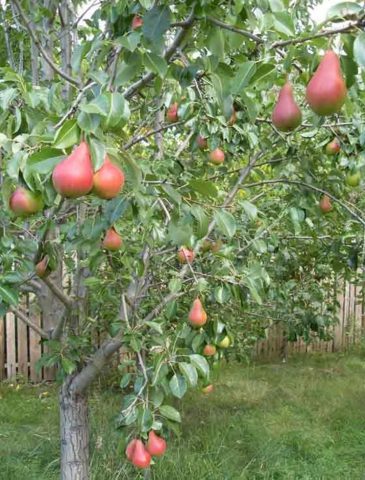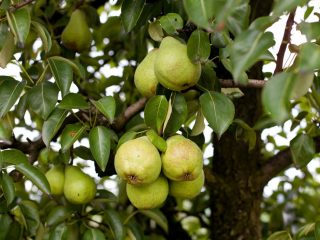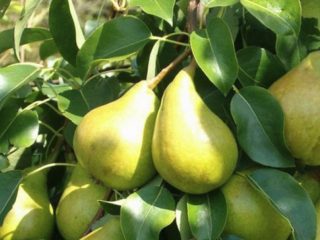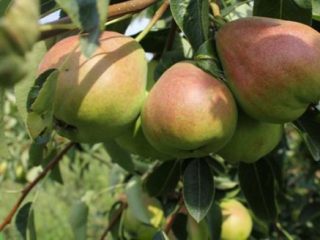Content
Pear Naryadnaya Efimova is a variety of Soviet selection that is still readily grown by Russian amateur gardeners. Its constant “demand” is determined not only by the presentable appearance of the fruit, which the name clearly hints at. The variety is characterized by stable fruiting, very good yield and good immunity. It is undemanding in care, but, of course, it has its own nuances of agricultural technology.
History of origin
Pear Naryadnaya Efimova is a variety created by the famous Soviet breeder V. A. Efimov, created in the mid-30s of the twentieth century at the experimental stations of the All-Russian selection and technological horticulture and nursery industry. Now the originator is the “legal successor” of this organization - the Federal State Budgetary Institution Federal Scientific Center for Horticulture.
The “parents” of the Naryadnaya Efimova pear were extremely famous varieties - the Russian Tonkovetka and Lyubimitsa (or Favorite) Klappa from the USA.She had to wait a long time for “official recognition”: the application for state registration was submitted in 1963, the necessary tests stretched for another 11 years. Since 1974, the Elegant Efimova pear has been listed in the State Register of Breeding Achievements.
Description of the Elegant Efimova pear with photo
The attractive “appearance” of fruits is an important factor; gardeners inevitably pay attention to this when choosing. The tree of the Naryadnaya Efimova pear variety cannot boast of an original “appearance”; it looks quite “standard”.
Tree
The Elegant Efimova pear reaches a height of 4.5-5 m and is characterized by a fairly rapid growth rate. The rounded crown turns into a pyramidal one as it matures. It cannot be called particularly thickened.

The degree of foliage is medium, the leaves are large, with a glossy sheen
The tree blooms in several “waves”. This rare feature allows, in the event of return spring frosts, to save at least part of the future ovaries. Unopened buds die at -4 °C, flowers - already at -1 °C.
Fruit
The fruits are symmetrical, classic “pear-shaped”, slightly elongated, without a funnel at the stalk. Average weight – 110-135 g. Rare “record-breaking” specimens gain weight 160-180 g.

Experts rate the “appearance” of fruit quite highly – 4.5-4.7 points with a maximum of five
The skin is smooth to the touch, slightly oily. The initial color is yellowish-green, but it is almost completely hidden by a dark crimson or red-burgundy “blush”. Subcutaneous points are small, multiple, clearly visible.
Characteristics of the variety
From the description of the Naryadnaya Efimova pear, which is confirmed by photos and reviews from gardeners, we can conclude that this variety is not unique, but “reliable” and “working”. Sometimes his “venerable” age is even considered an advantage, because all the advantages and disadvantages of culture have long been well known.
Taste qualities
The pulp of the Elegant Efimova pear is not too dense, but very tender and juicy, slightly oily, creamy-white in color (the skin can be pinkish), fine-grained when cut, and slightly aromatic. The taste is sweet, but not bland, with a slight “refreshing” sourness and a tart aftertaste. Many gardeners who have tried the fruit consider it close to dessert, although professional tasters do not agree with them. They rated the taste of the Naryadnaya Efimova pear as only four points out of five.
Ripening time
In terms of ripening time, the Elegant Efimova pear belongs to the autumn or early autumn variety. However, the fruits that ripen around mid-September must be removed from the tree when they are green. There is no way to be late with this.
Productivity
The productivity indicators of the Naryadnaya Efimova pear are rated as “average”. When grown on an industrial scale, about 30 tons are removed per hectare. Amateur gardeners can count on 40-50 kg per mature tree.

This variety bears fruit annually; resting seasons are extremely atypical for it.
You also need to take into account that you will have to wait a long time for the first harvest. The early fruiting rate of the Elegant Efimova pear is average; the first fruits are removed from the tree 6-8 years after transplanting the seedling into open ground.
Frost resistance
The winter hardiness of the Naryadnaya Efimova pear is described in the State Register as “average”. The experience of its cultivation allows us to assert that the tree can withstand prolonged frosts down to -25 ° C with minimal or no damage, especially when the snow cover is sufficiently thick.
Pear pollinators Naryadnaya Efimova
The Naryadnaya Efimova variety is recognized as self-fertile, but without the presence of pollinators it is unrealistic to collect good harvests. Pears are used for this purpose:
- Lada;
- Yakovlev's favorite;
- Elena;
- Muscovite;
- Victoria;
- Bessemyanka;
- Red-sided;
- Marble;
- Autumn bergamot.
Growing regions
The Elegant Efimova pear is recommended for cultivation in the Central region. For areas with harsher climates, it really lacks frost resistance. Therefore, in Russia the variety is in demand mainly in the middle zone.
From the republics of the former USSR, the Naryadnaya Efimova pear is grown in Ukraine, Moldova, Kazakhstan, Belarus, and Estonia. But it cannot be called extremely popular there.
Disease resistance
The Naryadnaya Efimova pear does not have “innate” immunity to fungal and other diseases. However, according to official variety trials, it is weakly affected by scab. Gardeners report virtually no cases of infection with moniliosis, rust, or bacterial burn.

Scab affects most of the fruits on the tree, turning them inedible, so having protection against it is always a plus for the variety
Other diseases also do not bother the tree too much, even in the absence of regular preventive treatments with chemicals.The same is with pests - they don’t particularly “single out” the Naryadnaya Efimova pear variety, but there is no guarantee that the tree will not suffer from them during a massive “raid” on the garden.
Advantages and disadvantages
Pear Naryadnaya Efimova was highly appreciated not only by “consumers”, but also by specialists. At the 1989 International Agricultural Exhibition in Erfurt (Germany), the variety won a gold medal due to its high commercial and consumer qualities of the fruit.

The Naryadnaya Efimova pear is still actively used by breeders when developing new varieties
Pros:
- very good resistance to pathogenic microflora and any pests;
- cold resistance sufficient for the growing region;
- stable annual fruiting;
- good yield for the crop, little dependent on the vagaries of the weather;
- transportability of fruits;
- presentable “appearance”, outstanding taste of pears;
- versatility of purpose.
Minuses:
- the height is quite high, which makes tree care and harvesting difficult;
- the need to plant pollinator varieties;
- the importance of the ability to accurately determine the moment of harvest in order to avoid spoilage of the fruit;
- average early pregnancy.
Landing rules
In central Russia and regions with a similar climate, both autumn and spring planting of seedlings in open ground is practiced. The main thing is to choose the right place for the Elegant Efimova pear. What is important for culture:
- good lighting;
- free air circulation, but without cold drafts and sharp gusts of wind;
- fertile, but not too “heavy” soil, allowing for normal air exchange;
- neutral substrate pH (5.5-6.0);
- groundwater lying 2 m below the surface of the earth or deeper.

Lack of light greatly inhibits the development of the tree; it will definitely not be particularly productive
Before planting the Naryadnaya Efimova pear, the planting hole must “stand” for at least 2.5-3 weeks, so it is always dug in advance. A layer of drainage is required at the bottom; a nutritious mixture of top turf, humus and fertilizers is poured on top. The approximate dimensions of the pit are 70-80 cm in depth and diameter.
The planting itself takes place according to the standard algorithm for seedlings of any fruit and berry crop. A minimum of 4 m is left between neighboring specimens of the Naryadnaya Efimova pear, and the row spacing is made even wider - 5-6 m.

The main thing in the planting process is to control the position of the root collar.
Features of care
No deep knowledge of agricultural technology is required to grow the Naryadnaya Efimova pear. It gets by with standard measures:
- Watering. The variety cannot be called very drought-resistant: with a lack of moisture, both the presentation and taste of the Naryadnaya Efimova pears suffer. Therefore, in the absence of precipitation, the soil is watered every 8-10 days, in hot weather - twice as often. It should also be taken into account that the “critical” periods for a crop, when it especially needs water, are flowering and the formation of ovaries. The approximate norm is 60-80 liters.
- Feeding. Trees begin to be fed from the second season in open ground.The scheme is standard and includes four feedings: nitrogen (at the beginning of the growing season) and three complex ones (immediately before flowering, 2-2.5 weeks after it and about a month after harvesting).
- Weeding and loosening. It is necessary to loosen the tree trunk circle after each watering, while simultaneously getting rid of weeds. However, if you cover it with mulch immediately after planting, you can avoid these procedures. Another advantage of this solution is that moisture from the soil will evaporate more slowly.
- Trimming. The crown of the Elegant Efimova pear is not too thick, but it requires sanitary pruning at the beginning and end of the season. A sparse-tiered configuration, which is formed over 3-4 seasons, is suitable for it.
- Preparing for winter. The required minimum of work to ensure wintering without damage is cleaning the trunk circle from debris, updating the mulch, and whitewashing the trunk. Feeding is also required, if the autumn is dry and warm - moisture-recharging watering. The gardener decides whether the trunk needs additional protection based on the long-term weather forecast.

Seedlings are watered more often than mature trees: in the first season after planting, the substrate should always be slightly moist
Collection and storage
In central Russia, the Naryadnaya Efimova pear ripens around mid-September. But they remove it 2-2.5 weeks earlier, in a state of “technical maturity”. Then the fruits need to be kept in a cool room for several days so that they “gain” the brightest and richest taste possible. “Readiness” is indicated by a change in the shade of the skin from greenish-yellow to amber-burgundy.
The Naryadnaya Efimova pears ripened on the tree are noticeably inferior to those ripening at home.They have pulp of an incomprehensible viscous-watery consistency, not at all sweet, with an unpleasant mealy aftertaste.
Like any pear, Elegant Efimova is not known for its keeping quality. The limit for her is 2.5-3 weeks. The fruits are kept in the refrigerator or cellar, basement, where you can provide:
- constant temperature 2-3 °C;
- air humidity is about 75-80%;
- lack of light and cold drafts.
Conclusion
Pear Naryadnaya Efimova is a variety practically devoid of significant shortcomings. This, as well as its merits, can be judged objectively: the rich experience of its cultivation, dating back more than 50 years, allows. The general endurance of the tree and its ability to survive negative external influences is successfully complemented by annual fruiting, very good yields in terms of volume, and a presentable appearance of pears.
Reviews from gardeners about the Naryadnaya Efimova pear









